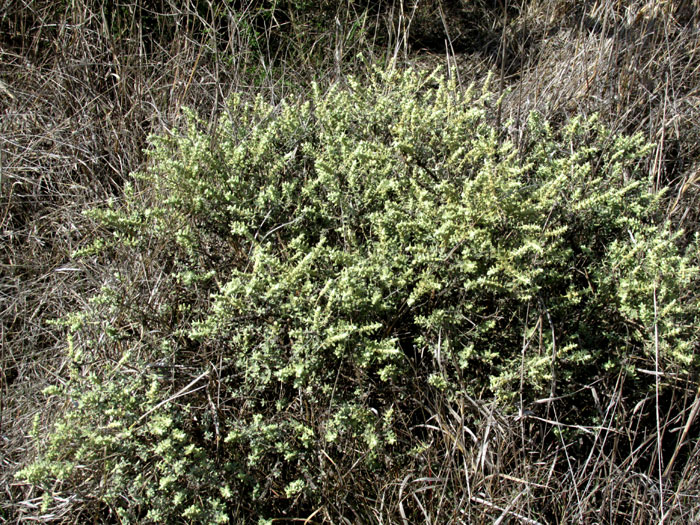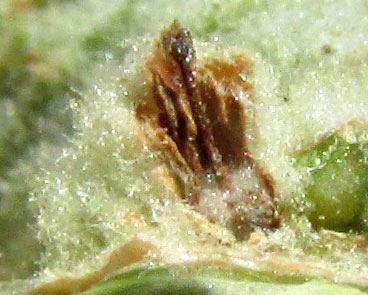Excerpts from Jim Conrad's
Naturalist Newsletter
entry dated July 27, 2022, issued from near Tequisquiapan, elevation about 1,900m (6200 ft), N20.565°, W99.890°, Querétaro state, MÉXICO
ESCOBILLA BUTTERFLYBUSH

On a hillside devastated by sheep grazing and firewood gathering, but with small patches of natural vegetation here and there, the above woody-based bush grew about a meter tall (1yd), looking rather healthy and at home. You can see that the rainy season hasn't come this year so the grass still is parched gray and brown, but the bush's branches were loaded with leaves and flowers. Here's a close-up:

The small leaves occur opposite one another on stems, and their margins are scalloped. Both leaves and stems are densely coated with white hairs. The hairiness thickens at branch tips, and the compact clusters of flowers form closer to one another.

Above it's seen that individual hairs are variously branched, or "stellate," giving the hairiness a fluffy nature, and better insulating the flowers and vegetative parts from extremes of temperature and sunlight radiation, and reducing water loss. Though each branch tip bears dozens of flowers, usually only one or two flowers are open at one time. Along the branch, flowers above the open blossoms are immature and closed, while those below the flowering ones already have been pollinated, the corolla has fallen off, and the ovary has begun ripening into a future fruit.

The flowers are tiny, with corolla lobes only about 0.07 mm wide (~1/32 inch). At the right in the above picture the somewhat three-lobed, greenish thing in the blossom's center is the stigma where pollen grains are to germinate. The four flattish items where the corolla lobes meet are pollen-producing anthers of stamens mounted on the corolla wall somewhat below the stigma's level. At the left in the above picture , a dark stigma stands atop its style, which in turn arises from the ovary deeper into the flower. All the hairiness around the yellow corollas derives from the flowers'calyxes. The flowers are so closely packed and the hairiness so thick that the stem itself is hidden.

At the right I've removed the corolla half covering this side of the flower, revealing the swelling ovary as it matures into a fruit. Note that the ovary itself is densely hairy, as well as the exterior of the fading corolla lobes and tube. Now that the stigma and style atop the ovary no longer are needed, they're drying up, turning brown, and soon will fall off. On both sides of the slender style you can see brown, shriveled stamens which will fall off with the corolla.

At the left, the older part of a stem bearing near-mature fruits is losing some of its hairiness and turning dark. At the right in the picture, the dried-out corolla tube covering the fruit has split, revealing the blackish, spherical fruit inside. The fruit itself is hairy, but less so than everything else.
Each mature fruit produced more than one seed. Until realizing this fact, I'd been unable to guess which family this plant might belong to. However, now all the above details came together to suggest the Snapdragon Family, the Scrophulariaceae, which produces capsular-type dry fruits containing more than one seed. The Scrophulariaceae volume of the online Flora del Bajío, which treats our semiarid, upland region of central Mexico, quickly directed me to BUDDLEJA SCORDIOIDES.
Buddleja scordioides is distributed from arid parts of Arizona, New Mexico and western Texas in the US south through northern Mexico, especially the Chihuahuan Desert, south to the Mexico City area. In the US it bears the English name of Escobilla Butterflybush. That's probably an editor's made-up name, since escobilla is the bush's traditional Spanish name, meaning "little broom," while the general name for all species of the genus Buddleja is butterflybush. Looking at the bush with its many small terminal branches, it's easy to visualize someone stepping from a hut in the Mexican desert, breaking off a branch and using it as an escobilla to sweep the floor. The outer twigs are soft and pliable, but the trunk is woody, and branching into several potential hardwood broom handles:

All the technical literature classifies our plant's fruits as capsules, though normally capsules are said to split in some way, in order to release seeds. These capsules don't split, but rather simply disintegrate as they age. It seems to be an effective way of spreading seeds, though, because Buddleja scordioides is common over much of its distribution, even described as a weed along roadsides in some places, thus able to thrive in disturbed areas, such as our abused hillside.
The bush's flowers are fragrant, though I didn't see many pollinators on it. Traditionally the bush has been used for gastrointestinal problems, especially diarrhea and stomach ache. Even still, when babies have colic, country folks may boil its twigs and roots in milk to make a tea the baby can drink.
A 2016 study by JO Díaz Rivas and others, entitled "Gastroprotective Activities of Buddleja scordioides -- Role of Polyphenols against Inflammation" states that "Buddleja scordioides Kunth is a plant that shows a wealth of important phytochemicals, which could contribute towards the prevention of various health problems such as gastrointestinal disorders."